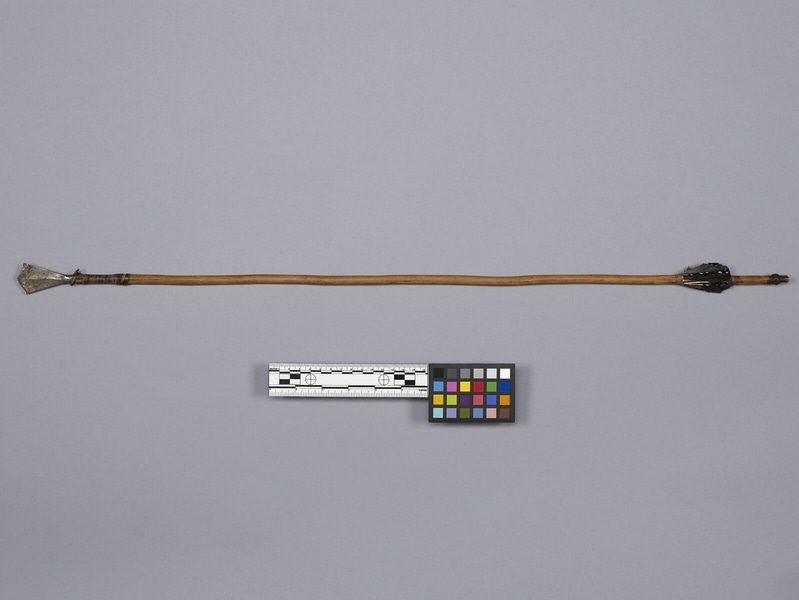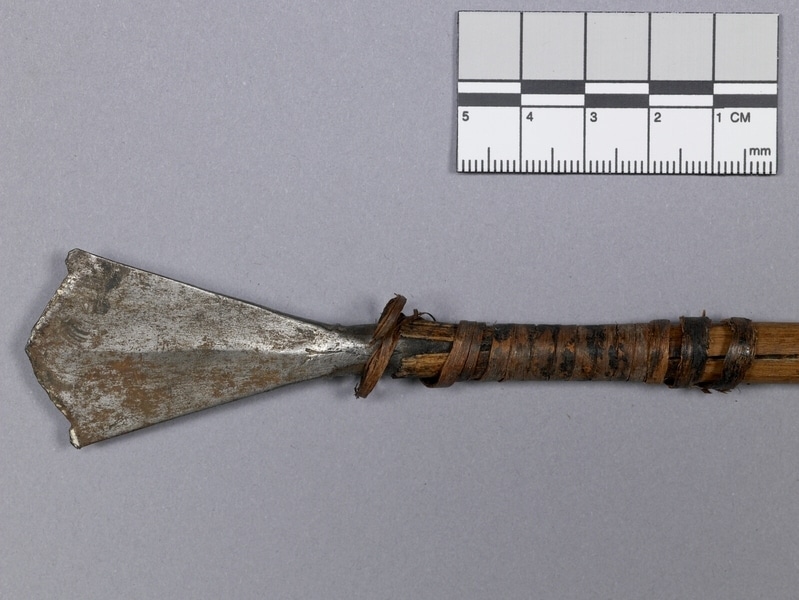Arrow Item Number: Ac234 from the MOA: University of British Columbia



Description
Yellow brown wood shaft that has one end inserted with tang of metal arrowhead then lashed with fibre. Metal head is fan-like outward from tang with fan's corners having small square projections. From these corners, the head forms a wide point. Shaft's butt end is notched and whipped with fibre. Short cut pieces of a dark brown feather and fibre-lashed vertically around shaft's circumference, some of which are white-spotted.
History Of Use
Used for weapon in warfare and hunting, although guns were increasingly used in warfare. Hunting was often conducted by a hunting-class among the Chokwe; there was considerable social and religious prestige associated with hunting. Chokwe peoples conducted hunts communally, whether as a village or as a group of villages banded together as one group. Collective hunts, whether by the hunting-class or by a communal group, occurred during the spring and summer, when the grass was high. Collective hunters would divide into two groups: one would light grasslands aflame and drive animals downwind, the other would capture and kill the animals fleeing. Individual hunting was also a profession. A professional hunter, known as a chianga or nyanga, would often be a small farmer in the off season. Hunters make their own arrow shafts with feathers; points are made by village blacksmith. The shape of the point on this arrow suggests a particular target or shooting context. Arrows are carried into field in a quiver of skin or woven basketwork. Arrow would have been used with bow taller than a person.
Cultural Context
Hunting
Narrative
The collector, Nellie Taylor, served as a nursing missionary (1900-1920), first with the Ovimbundu at Bihe, then with the Chokwe at luma Kasai. She belonged to a group who sponsored several missions across Central Africa from 1881-1931.
Specific Techniques
Whipping around end of feather attaches feathers to shaft as well as prevents the archer from cutting themselves on the feathers; whipping underneath self-nock prevents shaft from splitting past fibre if arrow is shot incorrectly.
Item History
- Made in Luma Kasai, Angola before 1920
- Collected between 1900 and 1920
- Owned by Nellie Taylor
- Owned by Gladys G. Cameron before January 12, 1979
- Received from Gladys G. Cameron (Donor) on January 12, 1979
What
Who
- Culture
- Chokwe
- Previous Owner
- Nellie Taylor and Gladys G. Cameron
- Received from
- Gladys G. Cameron (Donor)
Where
- Holding Institution
- MOA: University of British Columbia
- Made in
- Luma Kasai, Angola
When
- Creation Date
- before 1920
- Collection Date
- between 1900 and 1920
- Ownership Date
- before January 12, 1979
- Acquisition Date
- on January 12, 1979
Other
- Condition
- good
- Accession Number
- 0509/0011 b